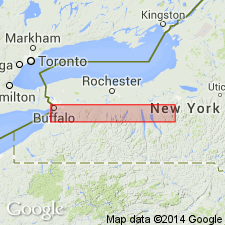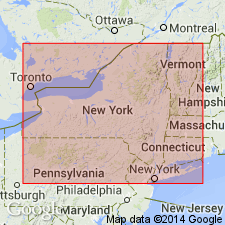
- Usage in publication:
-
- Taunton beds
- Modifications:
-
- Named
- Dominant lithology:
-
- Mudstone
- AAPG geologic province:
-
- Appalachian basin
Summary:
The "Spirifer-coralline" zone of Stover (1956) is here [informally] named the Taunton beds of the Windom Shale Member of the Moscow Formation of the Hamilton Group. The beds are a distinctive and widespread facies in the upper part of the Windom in Genesee, Livingstone, and Ontario Cos., NY. The Taunton consists of 5 to 6 m of fossiliferous, calcareous mudstone, too thick and variable to be designated a single bed, and contains rugose corals, brachiopods, and bryozoa. Overlies the Fall Brook Coral bed of the Windom. Age is Middle Devonian.
Source: GNU records (USGS DDS-6; Reston GNULEX).

- Usage in publication:
-
- Taunton beds
- Modifications:
-
- Overview
- AAPG geologic province:
-
- Appalachian basin
Summary:
In the Genesee Valley area, the Taunton beds consist of up to 3 m of moderately fossiliferous bluish gray ZOOPHYCOS-burrowed mudstone with abundant large fossiliferous concretions. Lowest portion tends to be blocky, sparsely fossiliferous mudstone with some brachiopods, but upward displays increase in shell and bryozoan-rich beds. Upper beds are rich in the brachiopods PSEUDOATRYPA, and MEDIOSPIRIFER, the small rugose corals, STEREOLASMA and AMPLEXIPHYLLUM, and the bryozoan SULCORETEPORA. Eastward the Taunton becomes increasingly silty. Eastern limit is presently unknown; interval is missing west of the Genesee Valley. Upper contact with the Spezzano Gully beds (new, informal) is marked by a compact argillaceous limestone termed the South Lansing coral bed by Baird and Brett (1983). Age is Middle Devonian (Givetian).
Source: GNU records (USGS DDS-6; Reston GNULEX).
For more information, please contact Nancy Stamm, Geologic Names Committee Secretary.
Asterisk (*) indicates published by U.S. Geological Survey authors.
"No current usage" (†) implies that a name has been abandoned or has fallen into disuse. Former usage and, if known, replacement name given in parentheses ( ).
Slash (/) indicates name conflicts with nomenclatural guidelines (CSN, 1933; ACSN, 1961, 1970; NACSN, 1983, 2005, 2021). May be explained within brackets ([ ]).

